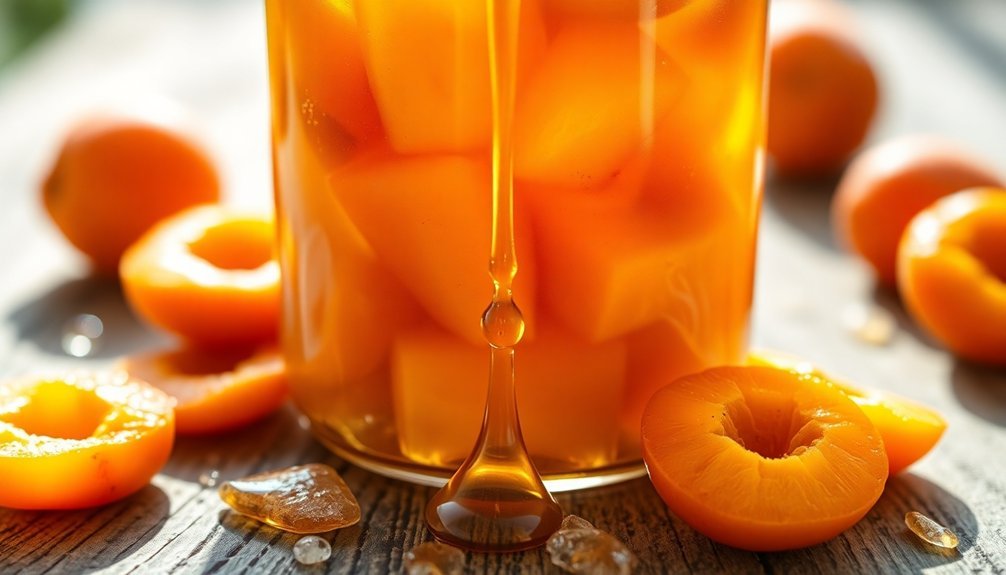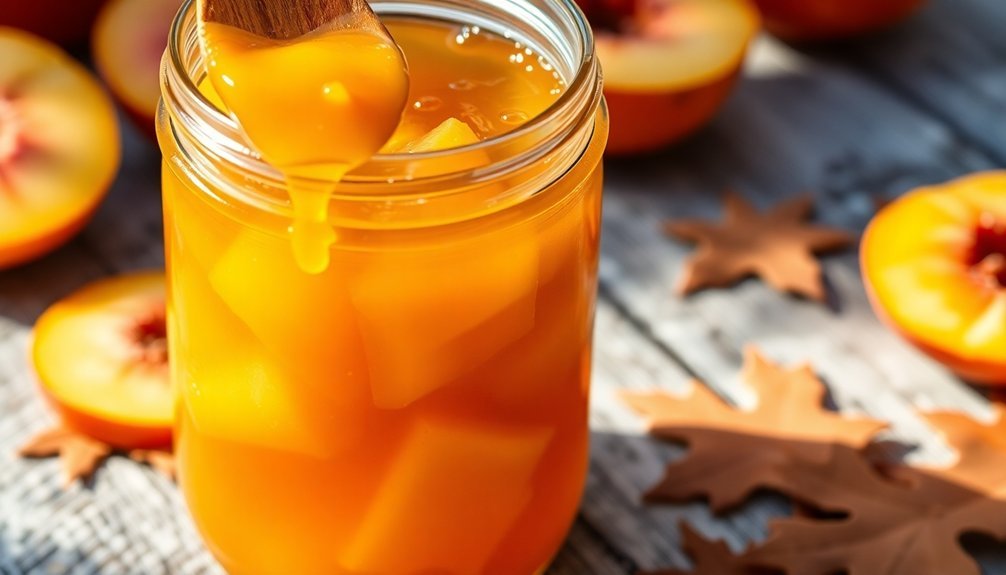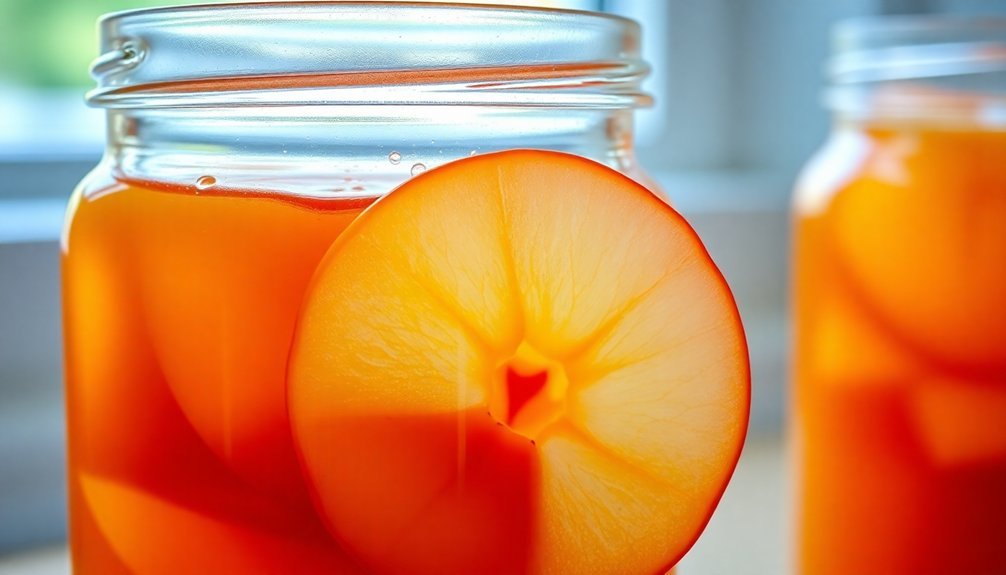You'll find these five stone fruit preserves irresistible and easy to make with minimal ingredients. Start with Classic Apricot Honey Preserves using just fruit, honey, and lemon juice, or try Mixed Stone Fruit Jam combining your favorite summer fruits. For a naturally sweet option, Maple Sweetened Peach Preserves lets you skip refined sugar. Spiced Plum Butter offers rich, spreadable comfort with warming spices, while Nectarine Vanilla Bean Preserves delivers elegant simplicity. Each recipe uses basic kitchen ingredients and offers multiple storage options to keep summer's flavors alive. Let's explore these delicious preserves that'll transform your breakfast table.
Classic Apricot Honey Preserves

Combine your apricots, honey, lemon juice, and chosen spices in a large stock pot over medium heat.
Cook the mixture for 30-40 minutes until it thickens. The natural pectin in apricots helps achieve the proper consistency. You'll know it's ready when a spoonful placed on a chilled plate sets properly.
Once the consistency is right, ladle the preserves into hot jars, leaving 1/4 inch of headspace.
Remove any air bubbles, wipe the jar rims, and seal tightly with lids and rings.
Process in a boiling water bath for 10 minutes before storing in a cool, dark place.
Mixed Stone Fruit Jam
Three summer stone fruits create magic in this versatile mixed jam. You'll need 4 cups of chopped stone fruits – any combination of apricots, plums, nectarines, or peaches. Mix them with 1½ to 1¾ cups of sugar and 2 teaspoons of citrus juice, then let them macerate for at least 15 minutes.
Cook your fruit mixture over medium-high heat until it reaches a thick boil at 215°F. You'll know it's ready when a spoonful doesn't run down a chilled plate. For a smoother consistency, use an immersion blender after cooking. Always ensure your tools and jars are properly sterilized before beginning the canning process.
| Storage Method | Duration | Temperature |
|---|---|---|
| Refrigeration | 2 months | 40°F |
| Freezing | 6 months | 0°F |
| Canning | 1 year | 70°F |
Add depth to your jam with optional ingredients like vanilla bean, cardamom, ginger, or jalapeño chile. If you're canning, follow USDA guidelines for proper sterilization and sealing. The natural pectin in stone fruits usually provides enough thickening, but you can use Pomona Pectin with calcium water if needed. Store your finished jam in a cool, dark place to maintain its quality.
Maple Sweetened Peach Preserves

Building on the versatility of stone fruits, this maple-sweetened version offers a unique twist on traditional peach preserves. You'll combine pure maple syrup with fresh peaches, creating a naturally sweetened spread that's less sugary than conventional preserves. The addition of vanilla and lemon juice enhances the fruit's natural flavor while maintaining the perfect balance of sweetness and acidity.
Three key elements make this recipe stand out:
- Pure maple syrup replaces most of the traditional sugar, providing rich, complex sweetness.
- Low-sugar pectin guarantees proper setting while allowing the peach flavor to shine.
- The combination of processing and hand-chopping creates an ideal texture with both smooth and chunky elements.
Start by blanching and chopping your peaches, then combine them with maple syrup, vanilla, and lemon juice. A ratio of 1 cup syrup per 4 cups fruit provides an excellent starting point for sweetness. After processing, cook the mixture with pectin until it reaches the right consistency.
You can store the finished preserves in several ways – refrigerate for short-term use, freeze for several months, or process in a water bath for shelf stability. The final product offers a delightful blend of pure peach flavor enhanced by maple's distinctive sweetness.
Spiced Plum Butter
Unlike conventional fruit preserves, spiced plum butter delivers a silky-smooth, concentrated spread that captures autumn's warmth in every spoonful.
You'll need 2-4 pounds of plums, sugar to taste, warming spices like cinnamon and allspice, lemon juice, and a small amount of water to get started.
Begin by halving and pitting your plums, then process them until smooth. Combine the processed plums with sugar, spices, and water in a saucepan.
You can choose between three cooking methods: stovetop, oven, or a combination of both. The stovetop method requires frequent stirring to prevent scorching, while the oven method offers a more hands-off approach.
You'll know your plum butter is ready when it's thick and spreadable.
For storage, you've got several options. If you're planning to use it within a few weeks, store it in airtight containers in the refrigerator. For longer storage of up to 18 months, process your plum butter using the water bath canning method. You can also freeze it, though this isn't as common.
Remember to sterilize your jars and lids if you're planning to can the butter.
Nectarine Vanilla Bean Preserves

Sweet nectarines and fragrant vanilla beans combine to create a luxurious preserve that captures summer's essence.
You'll start by dicing 2-2½ pounds of fresh nectarines into half-inch pieces, then mixing them with sugar and lemon juice. Split and scrape a vanilla bean, adding both the seeds and pod to the mixture before letting it macerate for at least 6 hours.
Here's what makes this preserve special:
- The overnight maceration draws out the fruit's natural juices and fully dissolves the sugar, creating a perfect jamming liquid.
- Separating and reducing the liquid before adding the fruit back guarantees a proper gel without overcooking the nectarines.
- The vanilla bean infuses throughout the process, complementing the stone fruit's natural sweetness.
When cooking, bring the liquid to a boil until large bubbles form, then add the macerated fruit.
Test for doneness by placing a drop on a frozen saucer – it should wrinkle when touched.
You can store your finished preserves in properly sealed jars for up to a year, or keep them in the refrigerator for two months if not processed in a water bath.
Frequently Asked Questions
Can I Substitute Frozen Stone Fruits for Fresh Ones in Preserves Recipes?
Yes, you can use frozen stone fruits in your preserves recipes. They'll work well as substitutes for fresh fruits, though you'll need to adjust cooking times and account for extra moisture when they're thawed.
How Long Will Homemade Stone Fruit Preserves Last in Unopened Jars?
You'll get the best quality from your homemade stone fruit preserves within 12 months if stored properly. When sealed correctly and kept in a cool, dark place, they'll remain safe up to 18 months.
Why Did My Preserves Turn Darker Than Expected During Storage?
Your preserves likely darkened due to light exposure, heat during storage, or the fruit's growing conditions. You'll want to store them in a cool, dark place to minimize color changes going forward.
Can I Reduce Sugar Without Affecting Preservation and Shelf Life?
You can't notably reduce sugar without affecting preservation and shelf life. However, you'll maintain safety by using low-sugar pectin and proper acid levels, though you'll need to store preserves for a shorter time.
What Causes Stone Fruit Preserves to Become Crystallized During Storage?
Your preserves can crystallize if you're using too much sugar, allowing slow cooling, storing with loose lids that let moisture escape, or not mixing sugar properly during cooking. Improper temperature control's also a factor.
In Summary
Now that you've explored these five stone fruit preserve recipes, you'll see how easy it is to capture summer's sweetness year-round. Whether you're spreading apricot honey preserves on toast or stirring maple peach preserves into yogurt, you'll enjoy these natural, homemade alternatives to store-bought jams. Don't forget to share your creations with friends and family – they make wonderful gifts for any occasion.





Leave a Reply